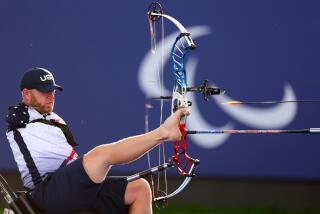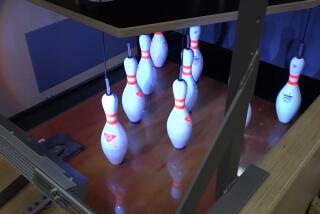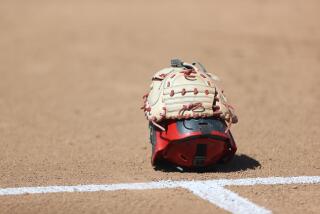Bows and Arrows Tug at Archers’ Heartstrings
Steve Hostetler bought his first bow and set of arrows at a garage sale when he was a youngster. He shot occasionally for a few years, then pretty much forgot about the sport.
He kept the bow, though, as he moved from house to house, even after he grew up and got married. One day, he took it out of the garage, dusted it off and shot a few arrows into the hillside in his back yard.
It was the beginning of a beautiful obsession.
“It’s a passion for me,” admits Hostetler, 40. The Placentia resident recently became a national champion in his category at a field archery tournament in Wisconsin, and he has several state championships under his belt.
Hostetler stands at the purist end of the sport. Although his bows are made from space-age materials, they retain the classic single-string designs made famous by every Robin Hood movie. The style, called bare bow, eschews using a sight on the bow or any of the other extras.
“I shoot bare bow because I like doing things the hard way,” Hostetler says.
The type of bow Hostetler uses is called a recurve. The more common bow among serious archers these days is called a compound bow. These complicated-looking instruments use wheels and cams to make drawing the bow easier, allowing a shooter to get 80 pounds of thrust from 40 pounds of pull.
For their speed and power, compound bows are favored among bow hunters, who make up the majority of archers. Hostetler estimates that 90% of serious archers are hunters. (Although he is exclusively a target shooter, Hostetler says he is not anti-hunting.)
Compound bows are commonly outfitted with sights (from simple pins to telescopic sights) and stabilizing bars. Although target shooters might opt for all sorts of wild colors, hunting bows are camouflage.
Archery is bigger in the East, Hostetler says, but the sport’s popularity is surging in the West. He is a member of Orange County’s biggest club, Oranco Bowmen, which owns a 56-acre range in Chino. The club, which also sponsors tournaments, has about 125 member families.
Other clubs in the county include El Toro Archers, which maintains a range on the El Toro Marine Corps Air Station, and a newly formed group in Coto de Caza. Public archery ranges are at Mile Square Park in Fountain Valley and Santiago Park in Santa Ana. Another popular spot for local archers is El Dorado Park in Long Beach, site of the ’84 Olympic archery competition.
There are several types of target competitions. In Olympic-style shooting, archers fire from a line at targets set at varying distances.
Field archery is a little like golf: Archers work their way through a meandering 28-target course, taking four shots at each target and keeping a running tally of scores.
A new type of target tournament is taking a big jump in popularity, according to several archers. Called 3-D tournaments , they are similar to field archery tournaments except that instead of hay bale targets, the archers shoot at life-size models of real animals, ranging in size from fox to moose. (One club in Northern California has a model elephant, according to Hostetler.)
The interest in 3-D tournaments is rooted in the growing popularity of bow hunting, according to Cameron McNee of Accuracy Archery in Orange, an archery pro shop that caters to hunters.
Many rifle hunters are coming to bow hunting because they enjoy the greater challenge, McNee says.
Rifle hunters can hit a target from 200 yards away, while bow hunters usually must get within 60 to 70 yards. Also adding to its popularity, the bow-hunting season is typically longer than the rifle hunting season.
A bow can cost from $150 to $800, McNee says. Arrows are a major investment: Aluminum arrows, still the most popular, cost about $40 to $50 per dozen, while new carbon arrows, which are lighter and faster, cost about $200 per dozen.
McNee recommends that someone interested in archery take a lesson before investing money.
Accuracy Archery and a new shop in Anaheim, Hi-Tech Archery, have indoor ranges and offer group and private lessons. Arrow Manufacturing Co. in Costa Mesa, another pro shop, does not have a range but works with a private instructor.
Archery instruction has all but disappeared from public schools, but youth lessons are offered through clubs and at some public ranges.
Although there are a few professional archers, Hostetler said that tournament prizes are so low it is unlikely a winner could make enough to cover even travel expenses. “It’s not like golf or tennis, where you can make a living,” he says.
Archery remains, even at the competitive level, a friendly pursuit where the experts are more than willing to share their advice with beginners, Hostetler says. Tournaments tend to be “just a social gathering with people who happen to be shooting archery,” he says.
At one time, there were tournaments available most weekends in Southern California, but that has diminished as public and club ranges in surrounding counties have closed because of development and the high cost of land.
The Oranco Bowmen range is open to non-members on Sundays, and some loaner bows are available for youngsters. Public tournaments are offered on alternating Sundays, providing first-timers a chance to observe competitive archers.
The range is on Euclid Avenue, just east of the Corona Expressway (Highway 71). For information on the club, call (714) 524-3228.
Public ranges are at:
* Mile Square Regional Park, 16801 Euclid Ave., Fountain Valley. Range open daily. Information: (714) 962-5549.
* Santiago Park, 2535 N. Main St., Santa Ana. Range open daily. Information: (714) 571-4200.
* El Dorado Regional Park, 7550 E. Spring St., Long Beach. Open daily except Tuesday morning. Information: (310) 421-9431.
Archery specialty shops include:
* Accuracy Archery, 610 W. Katella Ave., Orange. Information: (714) 771-2660.
* Arrow Manufacturing Inc., 1365 Logan Ave., Costa Mesa. Information: (714) 545-6102.
* Hi-Tech Archer, 9872 W. Katella Ave., Anaheim. Information: (714) 636-7476.


